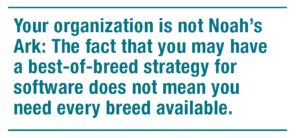A decade ago, I wrote a column for Workforce Solutions Review urging HR professionals to look beyond short-term workforce planning. At that time, when businesses were clawing out of a recessionary period, I implored readers to move from the tactical to the strategic:
What is strategic workforce planning? It is a holistic framework within which to assess and analyze the impact of internal and external trends on the future workforce by carefully considering alternate futures—different scenarios that may or may not come to pass. And it is essential for corporate agility; strategic workforce planning allows organizations to position themselves more quickly and intelligently for changing conditions.
We didn’t do such a great job with implementing this imperative planning. Why? Few considered a pandemic that would crush supply chains, kill millions, cripple hospitality industries, and exponentially increase the number of work-from-home workers. Few—maybe even fewer—are currently considering other “what-if” scenarios: a resurgence of mutating viruses, political instability, street violence that keeps all workers at home for their safety, escalating food or rent costs, or the threat of engaging in war. We don’t like to plan for things we don’t want to think about.

A decade ago, I wrote, “Strategic workforce planning is not staffing. Staffing refers to getting the right person in the right job at the right time–but rarely addresses the long-term questions that engage a strategic workforce planner. So staffing is essential–but it is not to be confused with strategic workforce planning.
Let’s Get Real
This must change.
Planning to Plan
It will be challenging to consider planning for the future if there is difficulty in ascertaining the present. Therefore, preparing for the workforce of tomorrow relies first on solid data on today’s workforce: where employees are, what skills they have, what roles they are in, and their likelihood of remaining with the organization.
While HR professionals have many more tools that generate analytics at their fingertips, there are some caveats:
- You likely have data from your HRIS system, perhaps a separate payroll system, and probably many more applications. If your corporate system has been best-of-breed, you may have multiple separate systems to extract data from.
- Integration is necessary: systems on which you rely for any employee data must be integrated so you can easily access ALL data you need. Easily.
- Your data must be trustworthy: if you get different numbers from payroll than you have in the HRIS system or can’t figure out PTO between your PSA system for service people and your HR system, you have a problem. Only you know if you feel the analytics presented to portray the state of your organization accurately.
- If you have a stand-alone analytics system, the data integration may be done for you—is it complete? Timely? Easy to access and understand?
- And importantly, can you access the data you need, no matter where it is? Do you have to jump through hoops to get data from sources outside of HR? And can you get information easily via single sign-on through the systems you have?
- Does the data you have access to matter? Organizations need to see trends in–for example, attrition, pay equity, promotion recommendations, and much more—even to consider future planning. Reports that only provide counts rarely give you data from which to make strategic decisions.

Why HR Needs Good Analytical Data
Ensuring the likelihood of a sufficient, competent, appropriately skilled workforce for the future is certainly not trivial: It takes thought, data, and time to hypothesize the “what-ifs.” HR professionals will need access to reliable external data and data native to their organizations. Knowledge of worldwide locations for advanced skill sets, trends in undergraduate and graduate school majors, worldwide demographic changes and changes in retirement policies, work locations by cost-of-living, safety, ease of access to public transportation and health care add to already recognized need for data on competitive salaries and housing and living costs in the regions where you employ people today. And more.
So let’s look at the “and more.” Data you can access with today’s tools will help your planning and comes from many different sources besides those noted above. Planning for the future requires a solid grip on questions such as these:
- How is your brand viewed today, and do you need to modify your public branding to attract the workforce you anticipate needing in the future? For example, if you are getting dissed on Glassdoor and Yelp, your ability to attract hires is already diminished.
- The perception of your company and its reputation is critical in the short and long term. Is that perception academic and a bit stuffy? A fun place to work? An excellent place to learn and get work experience? An organization that treasures the environment and supports charities. A firm with long hours and few perks, or that leads to burnout. You have access to survey tools to help you ascertain such views from alums, current employees, and those who applied that you did not hire or declined your offers.
- Your future sourcing strategies will likely be different than they are today. Data on, for example, which job boards are most attractive to which demographic, what candidates never submit resumes to job boards, which colleges have the best candidate placement offices for your recruiters to work with, and the like will change and adapt over time. Having the data now about what sources are most productively used is a start but start tracking new sources as they appear.
- Employee experience will—and, in fact, likely must—change. Vendors have been hitting this hard in the past few years, as companies buying software noted difficulties in attracting and retaining hires. Intuitive, modern interfaces are one thing, but policies must keep up. The glitziest user interface won’t make up for arduous arcane procedures that adversely impact employee productivity and satisfaction at work.
- Experience is more than touching the software: increased flexibility, support for remote work options, active programs for countering burnout to retain professionals in their field, such as extended R&R with pay if they will return to their positions, better support for parents, and those with elder care responsibility, job rotations and sharing, and creative programs to retain potential retirees at least part-time. What programs and policies have been successful in other companies? Other countries? These are all knowable things.
Analytic and survey tools can help you answer many basic questions to get you started – and in all these areas, tools using artificial intelligence and natural language processing can make finding and synthesizing data more efficient: face it, much of what you need to know could be time-consuming without AI aid.
Let’s use the data you gleaned for the “what ifs.” There are some ready examples that you and your firm already have contingency plans for:
- What if our data is breached and employee PII or customer data is released?
- What if stock price volatility affects our overall position in the market?
- What if recessionary and post-pandemic pricing continues to impact the cost of living?
- What if we have a massive power outage, face fire, or flood at our premises?
- What if something unforetold happens to a member of our leadership team?
- What if we are hit with a significant lawsuit, fraud, or embezzling issue?
- What if our number one supply chain provider goes under or disappears?
These are topics you and others in the organization have very likely thought about and have a disaster recovery or business continuity plan, even if informal, to address. Executive succession plans are likely in place as contingents for something catastrophic. (Note that many companies do not allow their executives to make business trips on the same aircraft – that is a contingency plan.)
The 200,000+ layoffs experiences across the U.S., especially in high-tech industries, are in response to one “what if:” What if the current recession and interest rates hikes continue into a waterfalling decline in consumer and business spending? This was a data-driven decision based on recent economic and labor-related statistics. In this context, however, it is a tactical, short-term decision rather than a 10+ years projection of labor force needs. Companies, particularly tech companies, rely on their cache to re-hire as they need in the future.
What Long-Term Planning Means for HR
Give at least some thought to the “what if’s” you don’t want to think about:
- What if a catastrophic disaster (like Turkey’s recent earthquake) hit your headquarters?
- What if a new war caused the conscription of your younger workforce members?
- What if the retirement age in 2035 is 80?
- What if the U.S. broke up as the Soviet Union once did?
- (One planner I consulted to wanted to consider “What if aliens invaded us,” but seriously, I don’t think we need to worry too much about that…on the other hand…)
In addition to solely workforce planning, HR professionals have several medium-term planning considerations to think about:
- What organizational structures would best support our company’s growth plans?
- How might social media and technology-related regulations in Europe affect future legislation in North America?
- What climate-protecting and sustainability changes should we plan on?
For all these considerations, you need data—from analytics within your company and externally. You need to know your current corporate strategy—not just the year ahead. As the strategic workforce planner – you are (yes, you are!) – try to look up from the morass on your desk to see further in the distance, contemplating scenarios that may occur and using data to plot the options the corporation will have should possibilities come to pass.



